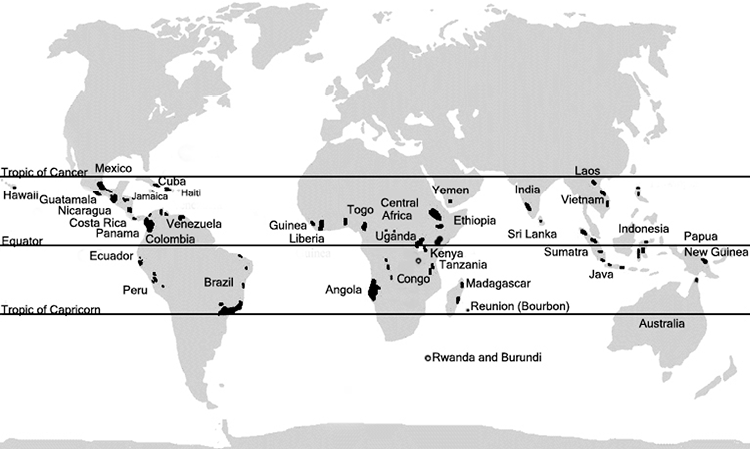Coffee
Coffee
A Comprehensive Guide to the Bean, the Beverage, and the Industry
Edited by Robert W. Thurston, Jonathan Morris, and Shawn Steiman
ROWMAN & LITTLEFIELD
Lanham Boulder New York Toronto Plymouth, UK
Published by Rowman & Littlefield
4501 Forbes Boulevard, Suite 200, Lanham, Maryland 20706
www.rowman.com
10 Thornbury Road, Plymouth PL6 7PP, United Kingdom
Copyright 2013 by Rowman & Littlefield
All rights reserved . No part of this book may be reproduced in any form or by any electronic or mechanical means, including information storage and retrieval systems, without written permission from the publisher, except by a reviewer who may quote passages in a review.
British Library Cataloguing in Publication Information Available
Library of Congress Cataloging-in-Publication Data
Coffee : a comprehensive guide to the bean, the beverage, and the industry / edited by Robert W. Thurston, Jonathan Morris, and Shawn Steiman.
p. cm.
Includes bibliographical references and index.
ISBN 978-1-4422-1440-8 (cloth : alk. paper) ISBN 978-1-4422-1442-2 (electronic) 1. Coffee industry. 2. Coffee. I. Thurston, Robert W. II. Morris, Jonathan, 1961 III. Steiman, Shawn.
HD9199.A2C59 2013
338.4'766393dc23
2013014865
 The paper used in this publication meets the minimum requirements of American National Standard for Information SciencesPermanence of Paper for Printed Library Materials, ANSI/NISO Z39.48-1992.
The paper used in this publication meets the minimum requirements of American National Standard for Information SciencesPermanence of Paper for Printed Library Materials, ANSI/NISO Z39.48-1992.
Printed in the United States of America
Preface
Putting this book together has been a great deal of work, but also a lot of fun, not to mention a terrific learning experience for the three editors. We have certainly learned a lot from each other. Just when you think you know something about coffee, you become aware of how much else you might explore. That is partly because the industry is changing so fast, from the way coffee trees are mulched to how to make a pour-over cup. But even if the industry stood still today, the amount of information available on any given aspect of coffee would be huge, and unknowable in its entirety for any one individual. That is why we have called on so many experts on one area or another of agriculture, processing, retailing, cup preparation, and consumption, to name a few fields.
We are deeply grateful to our contributors. Their generosity with their time and knowledge raises a basic question about the coffee industry: Why are coffee people so nice? Why, when academic historians like Robert Thurston and Jonathan Morris wander in, and at first dont know the difference between pulped naturals and pulp fiction, are coffee people so helpful? (The two of us consider Shawn Steiman a coffee person to the core.)
So while all three editors are proud of this book, we have also been humbled by making it. We hope that the articles will appeal not only to people in the industry and the millions of coffee fanatics (geeks, they sometimes style themselves) around the world but also to many others. This guide presents a wealth of information about a basic agricultural product that has played a major role in history, affects the economic and social life of many millions today, and is relentlessly studied and modified by scientists, roasters, baristas, and home consumers.
Although we have tried to produce a non-ideological work, the editors and contributors preferencesnot always in agreementwill become clear. Above all, weve aspired to provide a source of coffee knowledge for all who seek it and all who can benefit from it. We want the best for those involved with coffee, beginning with the farmers. We are dedicated not to charity or condescension but to the empowerment of industry members.
Finally, we hope this volume will be a pleasure to read.
Introduction
Robert W. Thurston
In this volume, the editors and the contributors have tried to provide a useful guide to coffee from the ground up. The articles we have assembled cover a great range of topics, from soil to roaster, barista, and home use. We are well aware that peoples tastes vary widely. Some prefer coffee in a grocery store can, already ground, or even instant coffee that requires almost no effort to prepare. Others pay considerably more money for select whole beans, which they grind before making each cup. They weigh the coffee and the water, then keep one eye on the temperature of the water and the other on the clock, as they count the seconds in the various steps of making the beverage. Still other folks want coffee only at cutting-edge cafsor, to use an upscale term, coffee barsmade by an experienced, skilled barista.
Whatever your particular pleasure in a cup, we believe that all aspects of the coffee industry should interest anyone who cares about the earth, farmers, globalization, or even basic economics. In these pages, a wealth of material applies first to coffee but also to wider issues; a good example is organic. Many coffee terms are explained in the glossary in the back of the book. If a term is in the glossary, it will appear in boldface the first time it is used in a chapter that discusses the term at length or in a context in which its meaning may not be clear. Since this is a handbook, readers may want to consult the index to find where the topics that most interest them are discussed. But of course all are invited to start with the first page and read straight through.
Everyone connected to the coffee industry has a story about the cup of coffee, the one that opened eyes, nose, and palate to the realization that coffee could be an excellent beverage. In the 1950s and 1960s, my mother made coffee in a steel drip pot, using ground, canned Maxwell House. I remember vividly that the results smelled and tasted like bitter, burnt metal. But there was that one intriguing puff of marvelous fragrance when she opened a new can. Years later, I happened upon a special deal for a kit with a carafe, a plastic filter cone, paper filters, and a can of ground coffee. All of a sudden, I had much better coffee than I had ever tasted before.
The cup, whatever it was for the initiated, opened the way for a journey deeper and deeper into the complexities and pleasures, along with disappointments, of coffee. If we can hook anyone into that journey with this book, we will be happy indeed. But this is not just a volume for snobs.
Thats partly because coffee begins with dirt. Agriculture is one of the most fickle businesses; growing and selling coffee is one of agricultures most volatile sectors. From planting a seedling until a tree bears usable coffee fruitcalled berries or cherry, usually in the singularcan take four years. The weather, war, emergence of a new producer (like Vietnam in the late 1990s), and changing tastes can wreak havoc on production and the price farmers can get for their beans, which are in fact the seeds of the coffee fruit.
Figure I.1. Where coffee grows. Map by Lara Thurston.
Boom-and-bust cycles have affected coffee from the 1880s on. In the 1930s, the bottom fell out of the market; Brazilians, the largest producers for decades, responded by dumping coffee into the ocean or burning it, producing steady smoke and an acrid odor over Rio. The price of coffee alternately soared and dove in the following decades, until it hit the miserably low figure of about 40 cents a pound in New York in the fall of 2004, at a time when it cost farmers at least 70 cents a pound to produce a crop, or more like $1 in many parts of the world. But in June of 2011, bad weather in several major producing countries, combined with increased demand for coffee, pushed the New York C price above $3 before it began to subside a little.
Next page
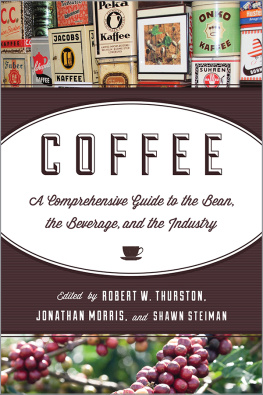

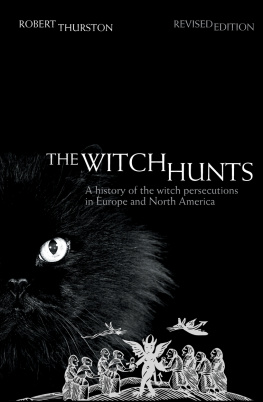
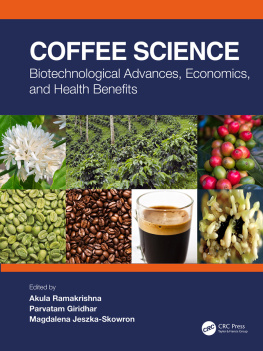

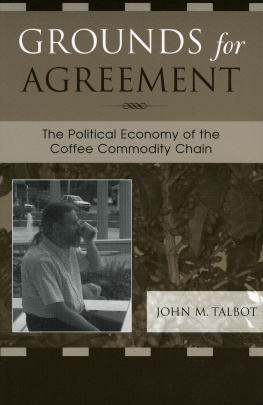
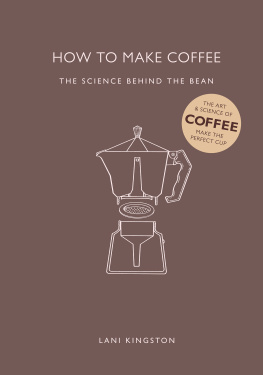
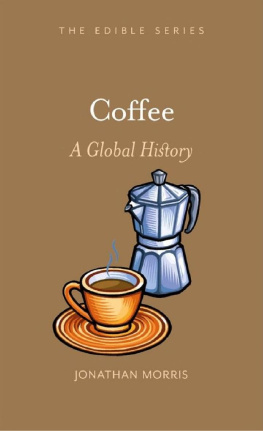
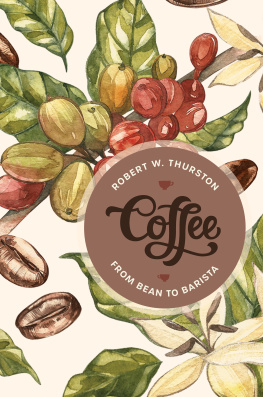
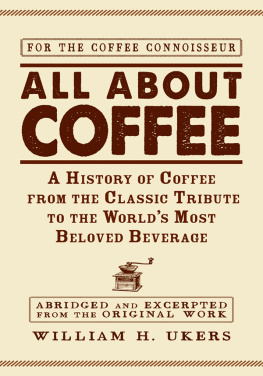

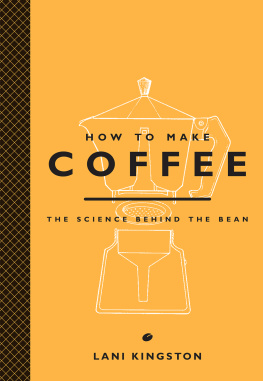
 The paper used in this publication meets the minimum requirements of American National Standard for Information SciencesPermanence of Paper for Printed Library Materials, ANSI/NISO Z39.48-1992.
The paper used in this publication meets the minimum requirements of American National Standard for Information SciencesPermanence of Paper for Printed Library Materials, ANSI/NISO Z39.48-1992.